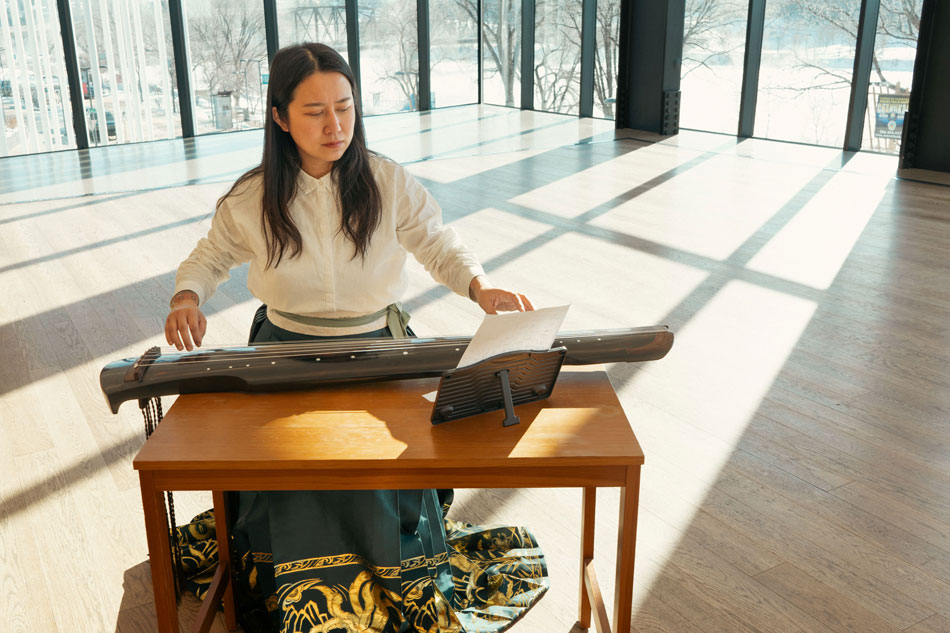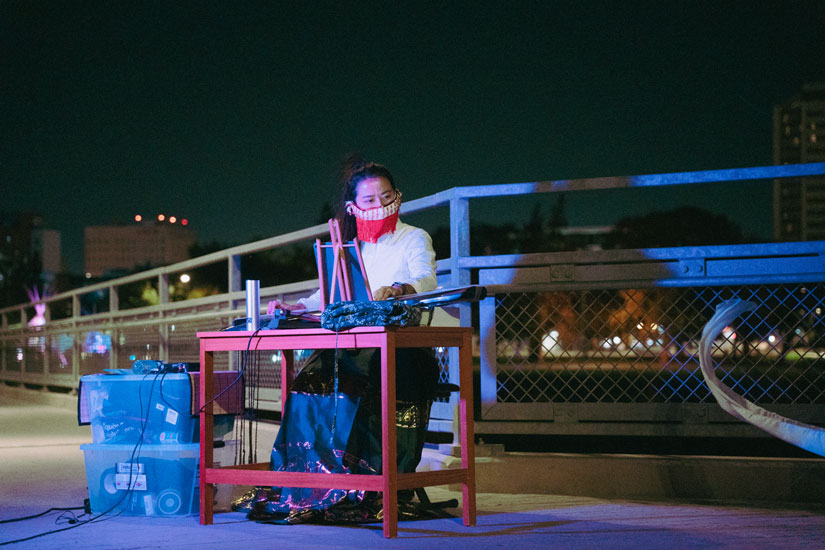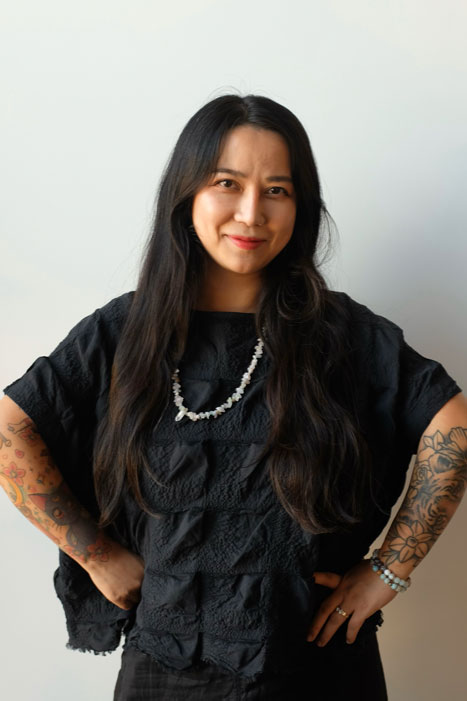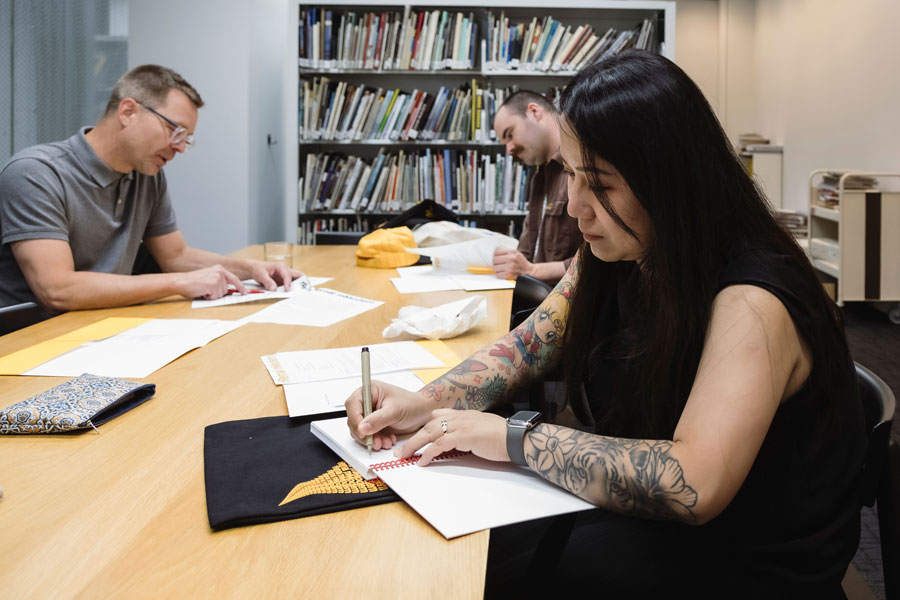
Building relationships through art
Through her multidisciplinary practice, Xiao Han (MFA’16) explores her identity as an immigrant artist while learning about life on the Canadian Prairies
By SHANNON BOKLASCHUKUniversity of Saskatchewan (USask) graduate Xiao Han (MFA’16) is a leader in Saskatoon’s arts community.
Han, who is originally from Wuhan, China, moved to Saskatchewan in 2013 to pursue a Master of Fine Arts (MFA) degree at USask. Since then, the multidisciplinary artist and curator has made her home in Saskatoon and has lent her talents and expertise to local organizations and projects, including serving as the chair of the board of directors at PAVED Arts, a non-profit, artist-run centre for production, presentation, research, and dissemination of contemporary media arts.
This year, Han will also serve as the festival curator for Nuit Blanche Saskatoon, a free all-ages nighttime arts festival scheduled for Sept. 20, 2025. It’s a role she’s excited about after previously performing at the festival and admiring the artists’ work.

“I do always want to curate, so it’s finally a turn for me,” she said in a recent interview with the Green&White.
Now based on Treaty 6 Territory and the Homeland of the Métis, Han’s creative practice focuses on photography, lens-based performance, visualizing emotion, and community engagement. Her research explores diaspora identity, contemporary gender issues, and the relationship between humans, the environment, and Indigenous land. She has also produced numerous projects that examine the history of Chinese-Canadian restaurants, the identity of home, and the esthetic of community relationships.

While culture and language are important themes in Han’s work, when she first moved to Canada and pursued a Bachelor of Fine Arts (BFA) degree at Thompson Rivers University in Kamloops, B.C., exploring her Chinese heritage wasn’t at the front of her mind.
“When I was in my BFA for the first three years, to be honest, I tried to resist it—like, I tried not to mention it,” she said. “You know, you try to blend in—like you want be one of the rest of the students.”
Han’s perspective changed when she was in her fourth year of her undergraduate degree. At that time, she worked on a project based on China’s one-child policy, and she felt the research involved in that work ultimately led her to learn more about herself. She is now actively seeking to build cultural connections through her art, as she shares her lived experiences as a Chinese immigrant artist residing in Saskatoon and seeks to learn more about Indigenous Peoples as well as settlers to the area.
“I really care about the relationships, relationship building,” she said.
In an interview published on Remai Modern’s website, Han talked about how she draws upon her upbringing in China to bring a personal element to her artistic practice, weaving her cultural heritage into Canadian contexts. In this way, she sees herself as a “bridge between cultures,” she said.
“I carry this Chinese heritage culture, and also my experience in Canada,” she said in the Remai Modern interview.
Today, as a sessional lecturer in USask’s School for the Arts in the College of Arts and Science, Han is involved in planning for the university’s Asian Heritage Month activities that will take place in May. She is the curator of the upcoming Asian Heritage Month Art Exhibition, which will be on view starting the week of May 19 at the Gordon Snelgrove Gallery. Part of the exhibition will showcase the work of Asian student artists from countries such as China, Syria, Iran, Vietnam, Philippines, and Bangladesh. Han wanted to curate the show because she had noticed that many of the students were exploring themes of identity in their work, which resonated with her, and she wanted to bring their work to more viewers.
“I found that so impactful,” she said in the Green&White interview. “Every time I see their work I find it’s so meaningful that I wish more audiences can be able to look at it.”
Han’s own artistic practice began with photography. It’s a medium that’s fascinated Han for years, dating back to when her father purchased “a fancy camera” when she was a teenager, enabling her to further explore the art form.
“You just have that confidence—like I have this camera; I have to do something with it,” she said.

Studying photography sparked Han’s experimentation with self-portraiture. Her artistic practice has since expanded to include dance, storytelling, and music; she plays a plucked seven-string Chinese instrument called the guqin, which she enjoys for its meditative and atmospheric sounds. As her artwork continues to evolve, she is exploring how to best shape her performance-based practice through the RBC Sustained Artist Mentorship program at Remai Modern. Han is currently one of three artists involved in the program, which fosters a supportive environment for exploration and provides emerging and mid-career artists with access to facilities, curators, and community resources.

Collaboration and exploration are important aspects of Han’s practice. She founded Kyuubi Culture Artist Collective—a multidisciplinary artist collective based in Saskatoon that presents visual narratives through the perspectives of queer and immigrant artists—and she enjoys working alongside and engaging in conversation with other artists.
“I do recommend artists think about making art in a collaborative way,” she said. “First of all, two is bigger than one—and also some artists, like me, do get better inspiration or motivation when you have a team or when you can talk (to someone else).”
Han also draws inspiration from her family. As the mother of a three-year-old girl, she believes parenthood has enhanced her art.
“The parent-child relationship encouraged me to complete more creativities and inspired my work with photography and socially engaged art practice,” Han wrote on her website, xiaohanart.com.
Han credits USask and the Master of Fine Arts program with “lifting” her art career. Han enjoyed her time as a USask graduate student, noting that her professors offered support but also provided her and her fellow students with many opportunities to explore. She was particularly pleased with the interdisciplinary nature of the classes available in the College of Arts and Science, noting that she was able to take a spend a week at Emma Lake learning about the intersections of art and the environment, turning soil into pigment for artworks.
“Within Arts and Science, we have a great opportunity to do interdisciplinary practice, including art and many other science-based disciplines,” she said in the Green&White interview.
Now, as an alumna and a sessional lecturer, Han’s relationship with USask has come full circle, as she is able to teach and mentor students and aspiring artists. She also recommends USask to prospective art students, noting its “amazing” facilities and the opportunities to exhibit artwork on campus.
“The Master of Fine Arts program here is more than I expected,” she said.


